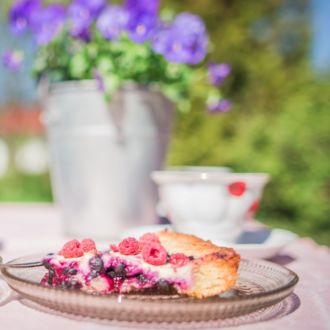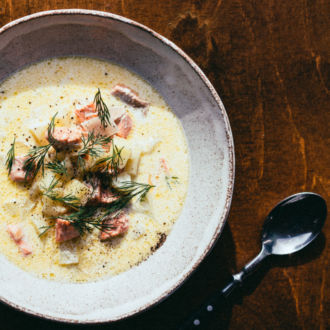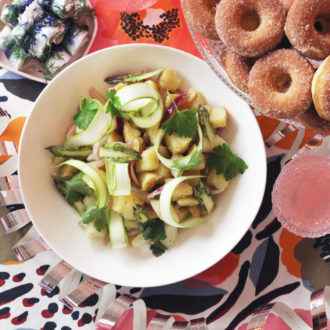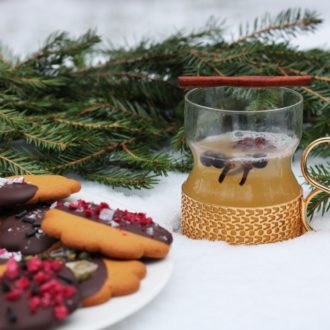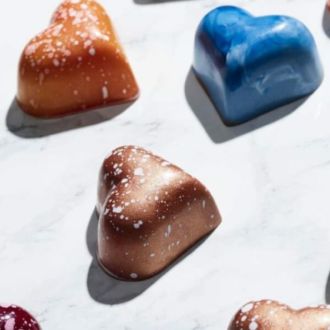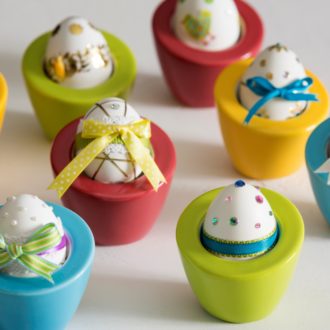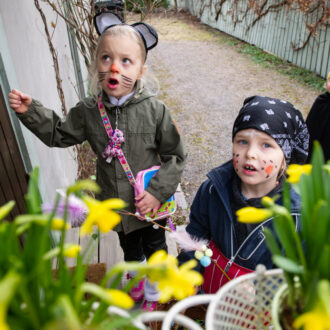When people think of eastern Finland, they often think of the country’s largest body of water. Lake Saimaa is an extensive, magnificent labyrinth of interconnected lakes, bays and islands with a water surface area of nearly 4,400 square kilometres (1,700 square miles).
People also know that one of Finland’s favourite foods comes from Karelia, the easternmost region of the country. The Karelian pasty, a small, thin-crusted pie filled with rice, is available in every grocery store across the nation.
There’s a stew named after Karelia, too, and we throw a few other delicacies into the mix, such as a vegan cabbage roll that is a cousin of the Mediterranean dolma.
[This is part of a series of recipe articles that show off dishes from the north, south, east and west of Finland – although many of them are now common all over the country – not to mention an extra piece about cake, bread and buns.]
By ThisisFINLAND staff, March 2022
Recipes and descriptions supplied by Timo Lepistö
Deep-fried pasties (lörtsy) from the Lake Saimaa region
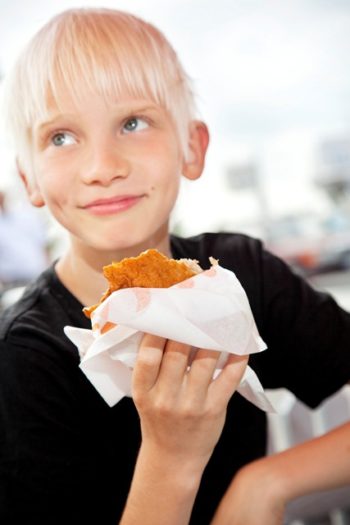
The lörtsy, a deep-fried pasty from the city of Savonlinna, can be prepared with many different kinds of fillings.Photo: Visit Savonlinna
There are many versions of deep-fried pasties in Finland but this thin one is specifically a speciality of the city of Savonlinna, which is better known for the world-renowned annual Savonlinna Opera Festival. The original lörtsy contained a mixture of ground beef and rice, but nowadays there are versions filled with everything from vegetables and fish to sweet apple jam.
Filling:
- 400 g of ground beef
- 1 onion
- 2 dl long-grain white rice
- fresh marjoram
- salt, allspice and white pepper
- cooking oil
Cook the rice according to the directions on the package and set aside in a bowl. Sweat the chopped onions for approximately ten minutes in a frying pan on low heat, then add to the rice. Fry ground beef on high heat and season with ground allspice, white pepper and salt. Mix all the ingredients, cover the bowl with cling film and refrigerate until needed.
Dough:
- 5 dl organic whole milk
- 25 g fresh yeast
- 1 tbsp sugar
- 1 tbsp salt
- 11 dl dark wheat flour (all-purpose flour is also OK)
- 2 eggs
- Deep-frying oil
Warm the milk to 37 degrees Celsius, add yeast and sugar, and mix well. Add the flour and salt, mix gradually and knead until shiny and firm. Cover and let rise for 45 minutes. Divide dough into 14 to 16 pieces. With a rolling pin, roll the dough into circles that are 3 to 5 millimetres thick. Brush each with egg wash and divide the filling between them leaving a border of two centimetres at the edges. Fold each one into a half-moon and press the edges together using a fork. Cover the pasties and let rise for 20 minutes. Deep-fry at around 190 to 200 degrees Celsius until medium brown. Drain well.
Karelian hot pot (karjalanpaisti)

Karelian hot pot is a hearty eastern Finnish dish that is well known throughout Finland.Photo: Elina Sirparanta/Visit Finland
This is a very traditional meat stew from Karelia. Along with Karelian pasties (karjalanpiirakat, see below), it is the most widely recognised Karelian food in Finland. In the eastern part of Finland, the same large oven was traditionally used for baking and for heating the whole house. After the oven had warmed the house, the oven’s residual heat was used to braise the ingredients. Traditionally, Karelian hot pot was a dish for harvest time. This version is a bit more elaborate than the traditional method, yielding a richer taste and a better texture.
- 500 g pork shoulder
- 500 g beef cheeks
- 5 large onions
- 2 carrots
- 10 allspice berries
- 1 sprig rosemary
- 1 star anise (optional)
- 2 bay leaf
- 1 tbsp salt
- cooking oil
Peel and slice the onions. Place a casserole over a high heat and add thin layer of oil in the bottom. Add the onions and optional star anise to cook until golden brown and lower the heat to medium. Stir the onions frequently to prevent sticking to the bottom of the casserole, approximately 40 minutes. Meanwhile cut the meats into 4-centimetre cubes. Brown the meats in small batches over a high heat with a skillet. Preheat the oven to 120 degree Celsius. Add meat, spices and salt to the casserole when the onions are done. Add water to cover the meat and heat to simmer, then cover with a lid and put it in the oven. Peel and cut the carrots to 2-centimetre cubes. After 2.5 hours of braising, add the carrots and the rosemary, then continue baking for 30 minutes. Serve with potato purée and lacto-fermented pickles.
Karelian pasties (karjalanpiirakat)

Egg butter, in the foreground, is a mixture of butter and soft-boiled eggs traditionally used as a topping for Karelian pies, shown in the other bowl.Photo: Elina Sirparanta/Visit Finland
This delicacy from the Karelia region is an iconic element of Finnish cuisine, popular all over the country. It was traditionally made with a barley filling; rice was used on special occasions such as weddings. There is also a version with a mashed-potato filling, called perunapiirakka, (potato pasty). Karelian pasties (also called Karelian pies in English) and dark rye bread are usually the foods Finnish people miss the most when living abroad.
Rice porridge:
- 1 litre milk
- 250 g short-grain rice
- 40 g butter
- 1 tsp salt
Put the rice in a large nonstick pan and add enough water to cover it. Bring it to boil, stirring constantly. Add milk and salt and simmer for 30–40 minutes, stirring occasionally. When the rice is cooked, take the pan off the heat source, add butter and mix gently. Add milk if necessary, to modify the consistency if the porridge becomes unworkably thick (this depends on the starch quantity of the rice).
Dough:
- 300 g rye flour
- 225 ml cold water
- 1 tsp salt
Combine the ingredients in a mixing bowl. Knead the dough until smooth and shape it into a log. Cover it with cling film and let it rest for 30 minutes.
Forming the pasties:
- 200 g butter
- 1 litre water
Melt the butter in a bowl and add warm water.
Preheat the oven to 250 degrees Celsius. Cut the dough into 24 pieces and roll each into a ball. With a rolling pin, roll each one into an oval shape. Stack them under a damp kitchen towel.
Place two tablespoons of the filling onto a piece of dough and fold the edges in towards the middle. Crimp neat, tight pleats and push the crimps down slightly into the filling to prevent burning. Bake approximately eight minutes. After baking, dip the pasties quickly individually into a butter and water mixture (immerse completely and remove), then let them cool under a clean kitchen towel.
Egg butter:
This is a traditional topping for Karelian pasties and rieska (Finnish flatbread – see our list of northern Finnish recipes). This recipe offers a good way to cook eggs to enjoy them with just a sprinkle of salt. The reason for soft-boiling the eggs is that it lets the yolks mix nicely with the butter.
- 3 eggs
- 150 g butter
- salt
Cut the butter into cubes, put them in a mixing bowl, and allow to warm to room temperature. Put the eggs into a small pot and cover them with water. Bring the water to boil over a high heat. After boiling for one minute, remove from the heat and let stand for nine minutes. Drain and then fill with cold water to cool the eggs. After cooling for ten minutes, peel the eggs and use a fork to crush them into the soft butter. Mix well and season with salt to taste. Cover and store in the fridge.
Vegan cabbage rolls (kaalikääryleet)
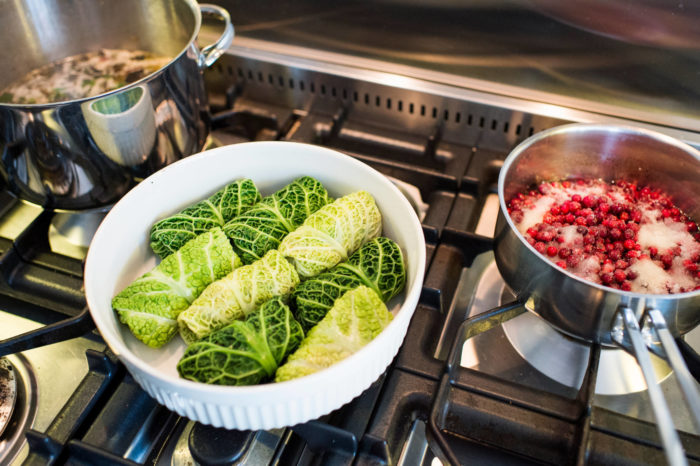
Many people consider stuffed cabbage rolls a delicacy.Photo: Juho Kuva/Visit Finland
The idea of cabbage rolls reached Finland from Turkey via Sweden in the 16th century. Cabbage leaves took the place of grape leaves, but otherwise it is easy to see the similarity between a dolma and a cabbage roll. The traditional stuffing is a mixture of minced meat and rice, but there are veggie versions as well.
- 1 head of cabbage
- 3 dl cooked pearl barley
- 200 g mushrooms
- 2 carrots
- 1 leek
- 2 cloves garlic
- 1 tsp fennel seeds
- 1 litre vegetable broth
- 2 tbsp dark syrup or muscovado sugar
- juice of half a lemon
- fresh thyme
- salt, black pepper
- cooking oil
Filling:
Thinly slice the mushrooms. Thinly slice the leek, grate the peeled carrots and mince the garlic. Place a sauté pan over a medium-high heat and add a thin layer of cooking oil. Add the mushrooms and stir until they start to brown, add minced garlic, leek and a generous amount of ground black pepper. Continue sautéing until leeks are soft, then remove from heat. Add fennel seeds, grated carrots, fresh thyme, and a bit of grated lemon peel. Season with salt and mix well.
Rolls:
Remove the white core of the cabbage. Bring a large pot of water to boil (large enough to fit the head of cabbage), then submerge the cabbage in the boiling water, until the leaves are tender and you can easily peel them away, one by one. About 12 pieces should be enough. With a knife, make a V-shaped cut on each leaf to remove the thickest part.
Put around 1/2 decilitre of the filling in the centre of a cabbage leaf. Roll the cabbage leaf around the filling and place the roll seam-side-down into a greased oven pan. Repeat with the remaining filling and leaves.
Preheat oven to 175 degrees Celsius. Mix the basting broth. In a bowl, combine vegetable broth, dark sugar syrup, lemon juice, salt and pepper. Bake the cabbage rolls for 90 minutes, basting periodically.
Berry pie with rye crust (mustikkakukko)

This type of pie has a rye crust and can be made with blueberries, as shown here, or with other kinds of berries.Photo: Kirsi Ilmaranta
Rye and berries are a wonderful combination, just add a bit of vanilla custard or vanilla ice cream and you have a perfect Finnish dessert. You can use any kind of berries, but usually people make it with either bilberries or lingonberries (wild relatives of blueberries and cranberries). In the Savo region of eastern Finland, this closed pie with a rye crust is called mustikkakukko or rättänä.
Crust:
- 250 g butter
- 5 dl rye flour
- 1 dl caster sugar
- 1 tsp baking powder
- 1/2 tsp salt
Filling:
- 500 g berries (for example bilberries or lingonberries)
- 1 tsp fresh thyme leaves (optional)
- 1–2 dl caster sugar
- 2 tbsp corn or potato starch
Whip softened butter and sugar until combined and fluffy. Mix the rye flour, baking powder and salt together and, using a sieve, sift the flour mix, then combine with whipped butter. Cover the dough and put it in the fridge for 30 minutes. Preheat oven to 175 degrees Celsius. Grease a pie pan or six smaller soufflé dishes with butter. Divide the dough, using two-thirds for the bottom and sides and one-third for the top. Press the dough evenly with your fingers into the base and sides of your selected dish. On a sheet of baking paper, form the remaining dough into a circle the same size as the dish. Mix the filling (if you are using fresh berries, reduce the starch by half) and pour it into the dish. With the help of the baking paper, place the dough on top. Then remove the baking paper and press the edges of the dough together along the rim of the pan. If using a larger pie pan, bake for 45–60 minutes (frozen berries require more time than fresh berries). For smaller pans, bake approximately 20–25 minutes. Let cool until lukewarm and serve with vanilla custard or vanilla ice cream.
Créme anglaise (Vanilla custard):
- 2.5 dl milk
- 2.5 dl heavy cream
- 1 vanilla pod (or vanilla extract)
- 1 dl caster sugar
- 6 egg yolks
Mix milk, cream, and split vanilla pod (remember to scrape the seeds into the milk, too) in a saucepan. Bring to a boil over a medium-high heat, then remove from heat. Put egg yolks and sugar into a mixing bowl and whisk until pale and fluffy. Add approximately 1 decilitre of hot milk to the yolks and whisk well – this helps temper the yolks. Pour the egg mixture back into the saucepan with the rest of the milk, stirring constantly. Place the saucepan on low heat and stir until the mixture thickens a bit. Pour the custard into a clean bowl and cool down with the help of cold-water bain-marie. Strain and put in a fridge to cool.
Finnish blinis (blinit)
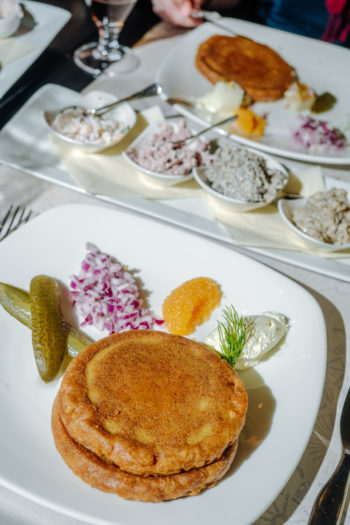
Finnish blinis are somewhat different from their Russian counterparts.Photo: Jussi Hellsten/Helsinki Marketing
These thick sourdough pancakes differ from the thin Russian classics that share their name. They are usually eaten in the wintertime with fish roe, sour cream (smetana) and diced onions, but cold smoked salmon or mushroom salad are also suitable. It takes two days to get the batter ready for frying. On the first day you make the sourdough, and on the second day you finish the batter and fry them.
First day:
- 5 dl milk
- 2.5 dl fine buckwheat flour
- 5 g fresh yeast (or 1/4 tsp dry yeast)
It is very important to keep everything clean. Warm the milk to 37 degrees Celsius. Mix yeast and milk in a large bowl and add flour, whisking vigorously to form a smooth batter. Cover with cling film and, after few hours, place the bowl in the fridge.
Second day:
- 1–2 dl all-purpose flour
- 1 1/2 dl lager beer (or créme fraiche)
- 2 tsp salt
- 2 tsp caster sugar (optional)
- 3 eggs (whites and yolks separated)
- Clarified butter
Put yolks, salt, beer and sugar into the first-day batter and mix. Adjust thickness with all-purpose flour until it resembles thick pancake batter. Add egg whites into a clean mixing bowl and whisk until stiff and shiny. Fold the egg whites into the batter in three batches until fully incorporated.
Place a pancake pan or a blini pan over medium-high heat and heat the pan thoroughly. Add a thin layer of clarified butter at the bottom of the pan and pour the batter, about 1/2 decilitre for each blini. Cook for about one minute or until bubbles form, then turn. Add a bit of clarified butter and cook for one minute. Serve hot with selected supplements.
Finnish traditional rye bread (ruisleipä)

This traditional Finnish rye bread takes time to make – several days, actually – but it’s worth it.Photo: Reijo Haukia/Lehtikuva
To get proper results, use fresh, organic, untreated, unsifted coarse rye flour. The bread’s typical taste and texture take time to form, so this recipe can take three or four days to make, but it is well worth it. Serve with butter, or any topping of your choosing, for example sea buckthorn gravlax (from our list of western Finnish recipes).
First day:
- 2 dl coarse rye flour
- 1 2/3 dl water
- 5 g fresh yeast
In a large bowl, mix yeast and water together. Mix flour into the water and set aside overnight. Do not cover.
Second day:
- 4 dl coarse rye flour
- 3 dl water
Mix into the first batch, cover with cling film and leave at room temperature overnight.
Third day:
- 6 dl coarse rye flour
- 1 dl water (if necessary)
- 2–3 tsp salt
Taste the starter dough. If it tastes sour and fresh, you can bake the bread. If not, ferment it an extra day.
Add the salt and the flour. Knead with a stand mixer with a dough hook for 20 minutes, or by hand about 30 minutes, until the dough is shiny. Cover with a clean kitchen towel and let rise until double in size, approximately 2–3 hours.
Divide the dough into two pieces, shape them into round loaves and put them on a baking sheet lined with baking paper. Dust a bit of flour on top, cover with a kitchen towel and let rise for two hours. Preheat the oven to 225 degrees Celsius. Prick the loaves with a fork before baking. Bake at 225 degrees Celsius for 20 minutes, then lower the heat to 180 degrees Celsius and continue baking about 40 minutes (core temperature about 96 degrees Celsius). Wrap the loaves in clean kitchen towels and let cool completely. This bread is at its best the day after baking, served with a good portion of salted farm butter.
